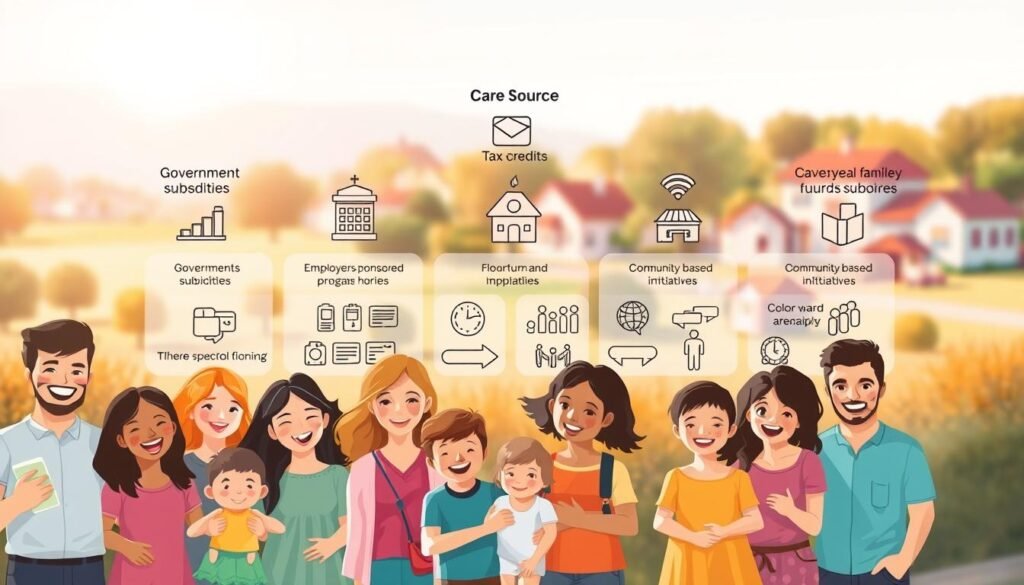
I remember staring at my budget last month, calculator in hand, wondering how daycare became our second-largest expense. It felt like a puzzle with missing pieces – rent, groceries, then child care costs swallowing nearly a third of our income. Sound familiar? You’re not alone.
Data shows many families spend more on child care than housing or college savings. The stress is real, but so are solutions. Federal and state programs exist to lighten this load, along with local resources most parents never hear about.
When I first explored assistance options, I was overwhelmed. Subsidies? Tax credits? Employer-sponsored plans? It took research, but uncovering these tools changed everything. Now, I want to share that clarity.
This guide walks through practical ways to reduce child care costs, from sliding-scale programs to community partnerships. Whether you’re juggling twins or navigating after-school care, there’s hope. Let’s explore how to make quality care fit your reality.
Key Takeaways
- Child care expenses often exceed housing costs for working families
- Government subsidies exist at both federal and state levels
- Local community programs frequently offer sliding-scale fees
- Tax credits can recover up to 35% of eligible care costs
- Employer-sponsored dependent care accounts provide pre-tax savings
Understanding Daycare Costs and Assistance Programs
Opening my bank statement last winter felt like peeling an onion – each layer revealed new tears. Our child care bill rivaled our mortgage, leaving little for emergencies or weekend treats. Why does quality child care carry such a hefty price tag?
Why Daycare Costs are a Big Part of My Budget
Three factors spiked our expenses:
- Staff-to-child ratios (more adults = safer environments)
- Facility maintenance and safety upgrades
- Location-based pricing (urban centers cost 40% more)
After touring six centers, I realized why prices vary. One director explained: “Accredited programs invest heavily in staff training and learning materials.” You’re paying for expertise, not just babysitting.
Overview of Child Care Assistance Programs and Resources
Relief exists through multiple channels:
- State vouchers covering 50-100% of fees based on income
- Nonprofit partnerships with child care providers
- Dependent care tax credits (save $1,800+ annually)
Eligibility requirements often surprise parents. Our household qualified for subsidies despite two incomes – always apply, even if you think you earn too much. Local resource hubs helped me compare programs side-by-side, revealing options I’d never found through Google searches alone.
how can i get help with daycare

My search began at the kitchen table with sticky notes and a lukewarm coffee. Three different browser tabs held answers: state portals, nonprofit sites, and IRS tax forms. “Where do I even start?” kept echoing in my head until I made a game plan.
Steps I Took to Explore Assistance Options
First stop: Early Head Start eligibility checks. Their income guidelines surprised me – thresholds were higher than expected. Next, I compared local child dependent care centers against home-based options. Pro tip: Ask about sliding-scale fees during tours.
Tax benefits became my secret weapon. Digging into dependent care tax rules revealed potential savings matching our care expenses. I created a spreadsheet comparing:
- Program costs vs. potential credits
- Employer benefits expiration dates
- State subsidy renewal cycles
Key Questions to Ask When Researching Funding
Armed with notes, I grilled program administrators (politely). “What documentation speeds up applications?” and “How do you handle income changes mid-year?” uncovered crucial details. Don’t skip asking about:
- Hidden fees in care programs
- Tax credit compatibility
- Waitlist contingency plans
Understanding the difference between care tax credit percentages and dollar caps saved us $2,300 last year. A children’s advocacy worker told me: “Families leave money on the table by not cross-referencing local and federal options.” Now I double-check every resource against both.
Navigating Government Programs for Child Care
I nearly missed the deadline for our state’s care assistance application last spring. Scrambling to gather pay stubs and birth certificates taught me one truth: government programs work best when you understand their design. These initiatives exist to support quality child development while easing family budgets.
Child Care Financial Assistance and Subsidies
States distribute funds through three main channels:
| Type | Payment Method | Eligibility |
|---|---|---|
| Vouchers | Direct to providers | Income-based |
| Certificates | Parent reimbursement | Employment requirements |
| Subsidies | Reduced tuition rates | Disability or risk factors |
California’s voucher system covers 92% of costs for qualifying families. Always ask providers which programs they accept – some centers specialize in subsidy management.
Head Start, Early Head Start, and State-Funded Prekindergarten
These early learning programs do more than supervise kids. A Head Start teacher told me: “We focus on child care development through structured play and nutrition support.” Enrollment requires:
- Income below 130% of poverty line
- Foster children automatically qualify
- Priority for homeless families
State pre-K options often bridge the gap between child care early years and kindergarten readiness.
Military Child Care Assistance Programs
Active-duty families pay just $9-12/day through MilitaryChildCare.com. The program caps fees based on rank and household size. One Navy spouse shared: “We combine base care assistance with local grants for summer enrichment.”
Documentation moves faster if you submit LES statements and deployment orders upfront. Many installations offer early learning labs focused on STEM skills.
Exploring Local and Employer-Sponsored Assistance

Last spring, a flyer at the library led me to a local child care resource fair I never knew existed. Hidden between pottery class ads and book sale notices sat gold: community-funded preschool scholarships and nonprofit partnerships. These local gems often fly under the radar but can slash costs dramatically.
Local Scholarships and Community Partnerships
Our city’s family services hub connected me with three funding sources I’d overlooked:
- Rotary Club grants covering 20% of summer camp fees
- Church-sponsored preschool programs with income-based tuition
- College lab schools offering 30% discounts for student-parents
A Head Start coordinator advised: “Check community boards at pediatric clinics – many local services post opportunities there.” Free pre-K availability varies widely by state, so I cross-referenced our county’s early learning website with mom groups on Facebook.
Workplace Child Care Solutions
My employer’s Dependent Care FSA became a game-changer. Contributing $5,000 pre-tax saved us $1,650 annually – enough for two months of diapers. Compare common workplace options:
| Benefit | Savings Potential | Eligibility |
|---|---|---|
| Onsite Centers | 10-40% off market rates | Full-time employees |
| FSAs | $5,000 pre-tax | All staff |
| Backup Care | 20 days/year subsidized | Often tech companies |
University hospitals and corporate campuses frequently partner with Head Start programs for employee discounts. Always ask HR about unadvertised perks – ours had a secret list of home-based services vetted by working parents.
Understanding Tax Credits and Additional Support

Tax forms used to give me hives – until I discovered they could be financial allies. Navigating credits felt like deciphering hieroglyphics at first, but cracking the code saved us $2,800 last year. Let’s break down two powerful tools that soften the child care cost blow.
Child and Dependent Care Tax Credit Details
The Child and Dependent Care Credit covers 20-35% of expenses up to $3,000 per child ($6,000 total). Here’s what worked for us:
- Saved every receipt from our accredited program
- Tracked summer camp costs for children under 13
- Used IRS Form 2441 with our tax return
Our tax preparer noted: “Families often miss this credit if they use employer-sponsored plans – you can combine both strategies.” We stacked it with our FSA, maximizing savings.
Earned Income Tax Credit and Other Tax Assistance Programs
For households earning under $63,398, the Earned Income Tax Credit offers up to $7,430. Key factors:
| Credit Type | Max Benefit | Age Limit | Income Cap |
|---|---|---|---|
| EITC | $7,430 | None | $63,398 |
| CDCTC | $1,050 | 12 years | $438,000 |
Last year’s tax credits covered three months of preschool fees. Pro tip: Update your W-4 if using employer-sponsored care accounts to avoid overpaying taxes.
Age requirements trip up many parents. Our 12-year-old’s after-school care qualified until her 13th birthday – we marked the date in red. When in doubt, consult a tax pro. One session clarified five years of confusion about assistance program overlaps.
Conclusion
A conversation with a neighbor revealed three childcare resources I never knew existed. That moment taught me what this journey proves: child care assistance hides in plain sight when you know where to look.
Combining federal tax credits with local care providers offering sliding-scale fees cut our expenses by half. The key? Treating research like detective work – cross-checking state programs with employer benefits and community learning initiatives.
Quality care isn’t a luxury reserved for top earners. Our family found accredited centers through nonprofit partnerships we’d never heard of during initial searches. Persistence uncovered layered support: scholarships stacked with tax breaks, military discounts paired with FSA savings.
Stay curious about new programs. Bookmark your state’s early education site. Join parent forums tracking child care assistance updates. The landscape changes faster than daycare snack rotations.
Three years ago, I nearly gave up. Today? Our twins thrive with quality caregivers while we keep costs manageable. Every exhausted parent deserves this peace – keep digging until you strike your golden ticket.

Leave a Reply